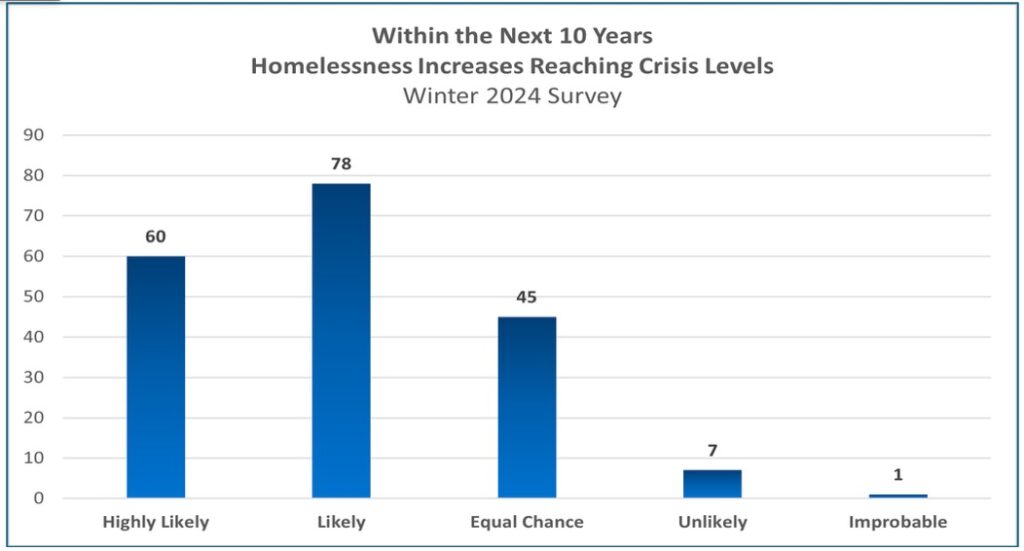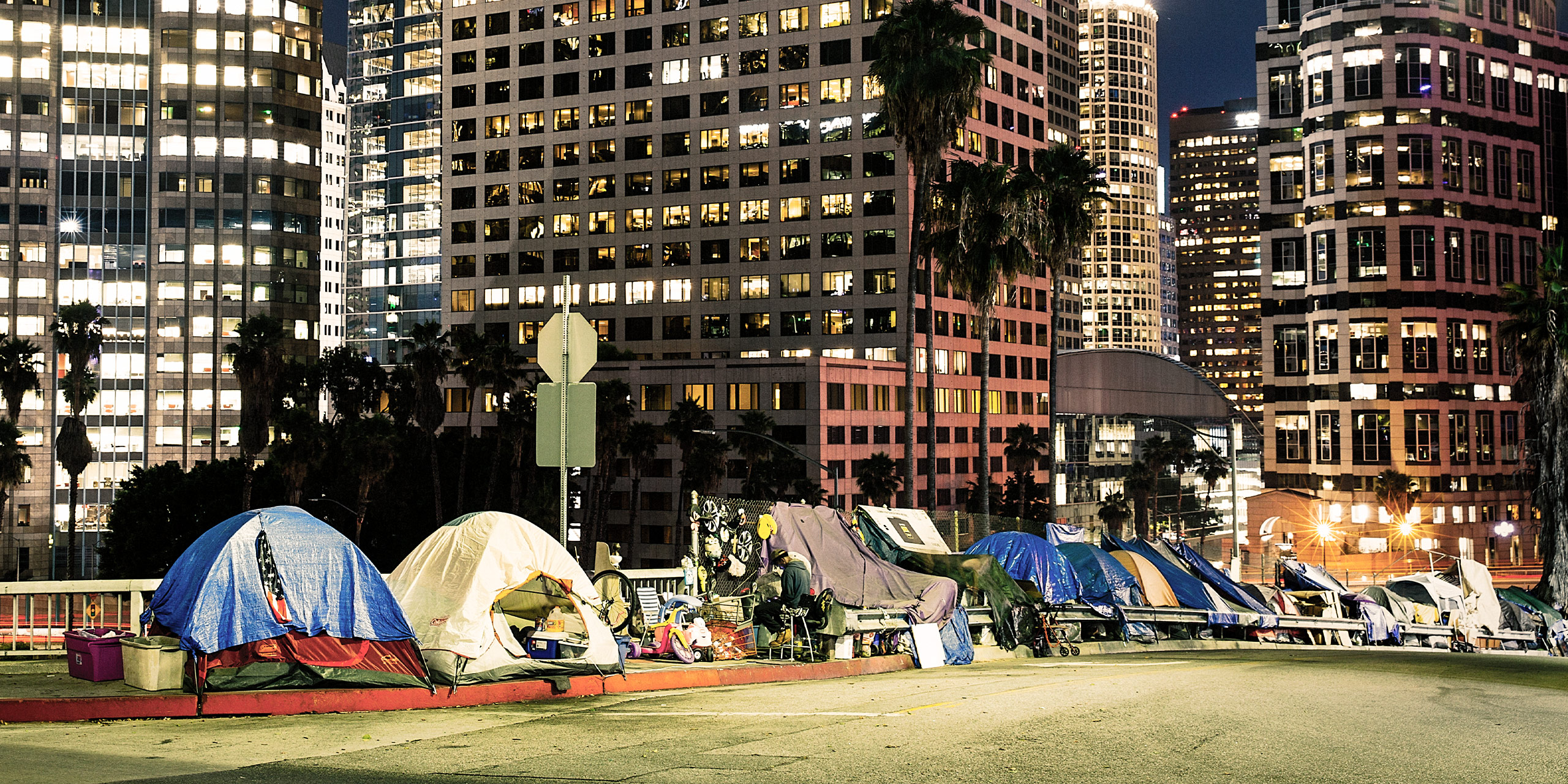The CourtFutures survey now tracks over 240 different scenarios since it began asking court professionals about the future and courts in 2012. Surveys to assess the likelihood of a particular scenario occurring within the next 10 years only scratches the surface of that scenario.
Each situation tells a unique story. Over the past 13 years, we have often wished for more time to explore them in greater depth. Until now, our efforts have been limited to publishing an annual CourtFutures Top Trends to Watch. However, with the rise of Artificial Intelligence, we believe we’ve overcome this challenge. We aim to publish regular analytical articles that provide deeper insights into timely and relevant scenarios.
We went to four of the more popular AI chatbots and asked them what the likelihood of a particular scenario is, why it is occurring, and what effect it would have on courts. The four chatbots used were:

Why Look for Trends?
Many courts adhere to the philosophy that they craft their own future. There is truth in that maxim, but it is just as important to know how the surrounding environment is trending and how such trends impact the work of the judicial branch. By monitoring trends in public perceptions, technology, and industry practices, courts can react to changes in current demands. Understanding trends helps courts make informed decisions, effectively allocate resources, and position themselves for long-term success in a dynamic social landscape.
The Scenario
Homelessness Increases Reaching Crisis Levels Although rates vary from region to region, homeless (or unsheltered) populations continue to increase. Homeless communities swell, stretching the limits of government services (including courts) that are focused on dealing with homelessness. DM.1.2024.40
This scenario was included in the Winter 2024 survey and received 191 responses. The overall group’s mean assessment was 2.0 (Likely).1
The scenario is prescient as homelessness in the United States jumped 18.1% in 2024, hitting a record level. More than 770,000 people were counted as homeless in federally required tallies taken across the country during a single night in January 2024.2 The estimate likely undercounts the number of unhoused people, given that it does not capture those individuals staying with friends or family.3

The CourtFutures Survey Group

The AI Chatbots’ Assessment of the Probability

Why the Chatbots Think This Scenario is Likely to Occur4
- Rising Homelessness Rates: The number of people experiencing homelessness has been increasing, and the trend is well-documented in many regions. While there are some local successes, the overall picture shows a continued upward trend or, at best, plateauing rather than a decrease.5
- Affordable Housing Shortages: There is a significant shortage of affordable housing in most, if not all, locations with a need, with millions of units needed to meet demand. Housing affordability continues to worsen in most major cities. The wealth gap continues to widen, creating more economic vulnerability.6
- Economic Challenges: High rental prices, inflation, and insufficient social safety nets are exacerbating the issue. Real wages have not kept pace with increased housing costs and inflation. Rising interest rates make homeownership less attainable.7
- Contributing Factors: Mental health and addiction services remain underfunded in many regions. Many current homeless services are reactive rather than preventative. Staff burnout in homeless services leads to high turnover and reduced effectiveness. Often, there is inadequate coordination between different social service agencies. There is increased investment in some areas, but the scale often does not match the problem.8
- Strained Government Services: Existing services struggle to keep up with the growing demand. Many local governments and courts are already overwhelmed by the challenges associated with homelessness, such as encampments, public health concerns, and legal disputes. Increased homeless populations will inevitably further stretch the capacity of government services, including courts. Housing-first programs, while effective, struggle to scale due to limited resources. NIMBY (Not in My Backyard) often blocks new shelters and affordable housing developments. The end of various pandemic-era housing protections has already led to an increased number of evictions. Many courts are already experiencing backlogs and challenges in providing adequate support.9
- Potential for Crisis: Without significant intervention, the trajectory of homelessness suggests it could reach crisis levels in some regions, particularly in areas with high housing costs or an inadequate social safety net. Remedying these issues by building new shelters and support facilities takes years of planning and funding.10
- Regional Variation: While the overall trend is concerning, it is important to acknowledge that the impact will vary regionally. Some areas may experience more dramatic increases than others. However, the scenario describes a general trend, not a localized one.11
Why Homelessness Might Not Reach a Crisis Level Within the Next 10 Years
- Government Interventions: Federal, state, and local governments may continue to invest in housing assistance, mental health services, and social programs aimed at reducing homelessness. For example, the City of Los Angeles has invested hundreds of millions of dollars to house unsheltered people in motels and move them into permanent housing. Initiatives like Housing First and expanded funding for affordable housing can help prevent a large-scale crisis. However, the current political climate makes continued Federal funding to support these programs and initiatives uncertain.
Conversely, increased enforcement of immigration laws could reduce homelessness, as some believe the majority of the homeless in large cities are made up of undocumented immigrants. This influx has caused the homeless population to skyrocket.12 This supposition is under debate, since surveys from Texas, California, and New York estimate the percentage of homeless who are undocumented immigrants as being between 5% and 10% of the overall homeless population.13 - Economic Growth & Job Opportunities: If the economy remains stable or grows, employment opportunities and wage increases could help more people afford housing, reducing the risk of mass homelessness. In addition, remote work trends may continue to reduce pressure on urban housing markets as people move to more affordable areas, potentially helping to stabilize housing costs in high-demand cities.14
- Private Sector & Nonprofit Efforts: Many nonprofits, religious organizations, and private sector initiatives are actively working to provide housing, food, job training, mental health services, addiction recovery programs, and case management services to mitigate homelessness. Increased collaboration between government agencies, non-profit organizations, and the private sector could lead to even more effective and comprehensive solutions to homelessness.15
- Housing Market Adjustments: While housing affordability is a major issue, some cities and states are working on policy changes, such as rent control, eviction protection, zoning reform, and incentives for developers to build more affordable units, which could help stabilize the situation.16
- Affordable Housing Initiatives: Efforts to increase the inventory of affordable housing are ongoing. This includes innovative housing solutions and technological innovations such as the development of tiny homes, 3D printing, modular housing, and the expansion of multi-generational households. Nationally, the inventory of housing has increased by over 16% since 2007.17
- Public Awareness & Policy Changes: The growing visibility of homelessness has led to increased public pressure on policymakers to take action, which could result in more proactive strategies to address the issue. A focus on housing-first approaches has shown strong success rates in various American cities. These programs prioritize getting people into stable housing before addressing other challenges like employment or addiction.18
How Will It Affect Courts?
- Evictions and Foreclosures: As housing insecurity grows, courts will likely see a rise in eviction and foreclosure cases. Tenants and homeowners will fight to stay housed.19
- Criminal Cases: Homeless individuals are often arrested for “quality of life” crimes like trespassing, loitering, or public camping, increasing the number of minor criminal cases. There will be an increase in drug possession and public intoxication cases, generating a greater need for court-appointed counsel.20
- Civil Disputes: Disputes over shelter policies, housing rights, and access to public services could become more frequent, leading to more civil litigation.
- Case Management Issues: There will likely be longer processing times due to increased caseloads. There will be more mental health holds and competency hearings, and an increased demand for drug treatment court services.21
- Court Administration Issues: There will be an increased strain on courthouse facilities (security, bathrooms, waiting areas). Additional administrative staff will be needed to handle paperwork. Scheduling will be more complex due to the added work of contacting defendants, maintaining current mailing addresses, and serving notices and summons. There will be more defendants failing to appear, and more difficulty establishing proof of identity once a defendant does come to court.22
Homeless courts or community courts may expand, and there could be a growing demand for new diversion programs tailored to unhoused individuals. Mobile court services, where judicial proceedings take place in specially equipped vehicles within homeless encampments, might also become more common. Additionally, the need for social workers and case managers will likely rise, further increasing court system operating costs.23 - Legal Challenges: There could be more constitutional challenges to anti-camping ordinances, increased litigation over property rights and public space use, and challenges to mental health commitment procedures. There could also be more cases involving the right to shelter and housing, and an increase in cases involving ADA accommodation.24
Conclusion
The convergence of economic, social, and systemic challenges paints a sobering picture for the next decade regarding homelessness in the United States. Both the CourtFutures survey group and the leading AI chatbots consistently assess this scenario as “likely” or “highly likely,” citing factors such as affordable housing shortages, economic pressures, and strained government services. The ripple effects on the judicial system—ranging from increased eviction, foreclosure, and criminal cases to administrative burdens and legal challenges—are expected to grow significantly unless comprehensive interventions are implemented.
We would love to hear your insights on the likelihood of this scenario occurring within the next 10 years. Email us at courtfutures@gmail.com. Also, we would love to have you take our 2025 CourtFutures survey.
ABOUT THE AUTHORS
Phillip Knox (ret.) previously served the general jurisdiction courts administrator for the Superior Court of Arizona in Maricopa County.
Peter C. Kiefer has spent over four decades working for the courts in Oregon, California, and Arizona, as well as on rule-of-law projects in Liberia, Moldova, and Beirut.
- Respondents are asked to assess the likelihood of scenarios occurring within the next 10 years based on a 5-point Likert-type scale: 1 being Highly Likely, 2 being Likely, 3 being Maybe (50-50 Chance), 4 being Unlikely, and 5 being Improbable. The results are then averaged and classified: 1.0 to 1.9 being Highly Likely, 2.0 to 2.4 being Likely, 2.5 to 2.9 being 50-50 Chance, 3.0 to 3.4 being Unlikely, and 3.5 to 5.0 being Improbable.
- National Low Income Housing Coalition, HUD Releases 2024 Annual Homeless Assessment Report, Jan. 13, 2025 (last accessed Apr. 8, 2025).
- CBS News, Homelessness surged 18% to a new record in 2024 amid a lack of affordable housing across the U.S., Dec. 27, 2024 (last accessed Apr. 8, 2025).
- We condensed and summarized the results, but the fundamental information is from the four chatbots.
- The U.S. Department of Housing and Urban Development’s 2024 Annual Homeless Assessment Report (last accessed Apr. 8, 2025).
- U.S. Government Accountability Office, The Affordable Housing Crisis Grows While Efforts to Increase Supply Fall Short, Oct. 12, 2023 (last accessed Apr. 8, 2025).
- Andrew Hall, Rising Rents and Inflation Are Likely Increasing Low-Income Families’ Risk of Homelessness, National Alliance to End Homelessness, July 17, 2022 (last accessed Apr. 8, 2025).
- Urban Institute Initiative, Addressing America’s Affordable Housing Crisis, Apr. 12, 2023 (last accessed Apr. 8, 2025).
- Angela Hart, The Supreme Court Confronts a Public Health Challenge: Homeless Encampments, KFF Health News, Feb. 28, 2024 (last accessed Apr. 8, 2025).
- Daniel Soucy, Makenna Janes, and Andrew Hall, State of Homelessness: 2024 Edition, Aug. 5, 2024 (last accessed Apr. 8, 2025).
- Hannah Love and Tracy Hadden Loh, Despite a National Spike in Homelessness, Some US Regions are Finding Solutions, Brookings Institute, Feb. 5, 2024 (last accessed Apr. 8, 2025).
- Samantha Kamman, Homelessness in US soars, tops over 770k due to illegal immigration: HUD, The Christian Post, Jan. 1, 2025 (last accessed Apr. 8, 2025)
- 2017 New York City Department of Homeless Services survey estimated that roughly 5–7% of the homeless population are undocumented immigrants. The Texas Homeless Network estimated that 5–10% of the homeless population are undocumented immigrants. A 2020 survey from the Los Angeles Homeless Services Authority (LAHSA) reported that about 7% of the homeless population were undocumented immigrants. A University of California San Francisco Benioff Homelessness and Housing Initiative (2023) found that 10% of the homeless population were undocumented immigrants.
- U.S. Bureau of Labor Statistics, https://www.bls.gov/emp/.
- Steve Redburn, Barbara Dyer, and Richard Callahan, Communities Collaborating to Reduce Homelessness, National Civic Review, Winter 2025, Vol. 113, Number 4.
- Alexander Soule, From rental aid to office conversions, CT proposal aims to tackle housing crisis, CT Insider,Mar. 6, 2025 (last accessed Apr. 8, 2025).
- See supra note 10.
- See id.
- National Low Income Housing Coalition, Coronavirus and Housing-homelessness, National Updates (last accessed Apr. 8, 2025).
- The National Coalition for the Homeless and The National Law Center on Homelessness & Poverty, A Dream Denied: The Criminalization of Homelessness in U.S. Cities, Jan. 2006.
- Clara Bates, Missourians wait an average of 8 months in jail for court-ordered mental health services, Missouri Independent, Sept. 20, 2023 (last accessed Apr. 8, 2025).
- Nate Raymond, New US courthouse design standards to result in higher costs, watchdog says, Reuters, Nov. 15, 2024.
- Ethan Corey and Puck Lo, The ‘Failure to Appear’ Fallacy, The Appeal, Jan. 9, 2019 (last accessed Apr. 8, 2025).
- Claire Rush, Fresh lawsuit hits Oregon city at the heart of Supreme Court ruling on homeless encampments, Associated Press, Jan. 30, 2025.



